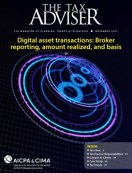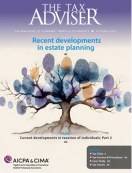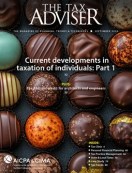- tax clinic
- STATE & LOCAL TAXES
Commonly overlooked business property tax compliance and valuation issues
Related
Notice 2025-27 provides interim guidance on corporate AMT
Two Tax Court rulings expose overvalued conservation easements
Late election relief in recent IRS letter rulings
Editor: Jessica L. Jeane, J.D.
The specialized field of state and local business property taxes can be challenging and sometimes difficult to navigate. Commonly overlooked compliance and valuation issues can lead to a higher tax liability than necessary. One of the most critical issues frequently missed is a company’s asset capitalization procedures. Inconsistencies within those procedures can distort values and trigger audits. It is also important to maintain a meticulous fixed–asset record and have a plan to review for any “ghost” assets that can cause an increase in property taxes.
Functional and economic obsolescence is another often–overlooked value issue within property taxes, as including obsolescence in the value calculation would reflect the asset’s true fair market value. Finally, many statutory exemptions and abatements are available that can unearth savings and create a much lower property tax liability. Together, these commonly overlooked compliance and valuation issues can provide a road map to future tax savings.
Capitalization procedures
Corporate tax professionals tasked with reporting fixed assets on property tax returns must understand their company’s asset capitalization policies. The asset capitalization policy defines the process for acquisition and approval of capital expenditures or projects. The policy should establish a floor for the cost of an asset before it is capitalized and becomes an asset on the fixed–asset listing.
For example, if the floor of the cost of an asset to be capitalized is $5,000, they should be aware that any assets costing less than that floor will be expensed. Most states require the reporting of expensed equipment. If the company is reporting to an audit state, this is an area that auditors frequently target, as they know it is often overlooked. If the expensed assets have not been reported, the company is at risk of noncompliance, resulting in additional tax liability and penalties over two or more years.
Once an asset is capitalized, it is important to understand the guidelines used by the fixed–asset accountant. They often capitalize multiple assets from a specific project as one asset with the total cost of the project. Included in this cost may be items that are not taxable, or they may be considered real property rather than personal property. When a component of this project or asset is disposed of, it most likely is not being removed from the total fixed–asset capitalized cost. Both scenarios result in overpayment of property tax year over year.
It is important to note that the fixed–asset system is used by a company to calculate and track accumulated depreciation and expense for both financial and income purposes, property insurance purposes, and other financial reporting purposes. These purposes are usually in conflict with the property tax reporting requirements.
Maintaining detailed records and identifying ghost assets
Maintaining detailed fixed–asset records is essential for accurate financial reporting and operational efficiency. One critical aspect of this process involves identifying ghost assets — fixed assets that are no longer in use or cannot be physically located on–site yet still linger on the accounting books. To uncover and eliminate these discrepancies, organizations should perform a comprehensive annual fixed–asset review and/or ghost–asset study. This involves first reviewing the current asset list to establish a baseline, then conducting a thorough physical audit or asset inventory to verify the existence and condition of each asset. Additionally, engaging local personnel through interviews can help clarify discrepancies and provide valuable insight into asset usage. During the process of interviewing local personnel, other valuation issues may be uncovered, including idle assets, reclassification issues, obsolete inventory, and other issues. In most states, the statutory depreciation tables reach a floor of only 10% to 30%, so there will always be a residual value on the assets reported. Ultimately, the goal is to pinpoint ghost assets and remove them from records to ensure accuracy, reduce unnecessary depreciation expenses, and improve resource allocation.
Functional and economic obsolescence
Functional and economic obsolescence are key factors that impact the value of fixed assets, particularly machinery and equipment. Functional obsolescence refers to the decline in value caused by internal inefficiencies when an asset no longer performs as effectively as newer, more cost–efficient alternatives.
In contrast, economic obsolescence stems from external market conditions, such as fluctuations in supply or demand, which can make assets less valuable even if they remain operationally sound. A common indicator of this is inutility or the underperformance of equipment relative to its intended capacity. The inutility calculation is used to quantify economic obsolescence. This involves comparing the actual production capacity of an asset to its rated (maximum) production capacity. The resulting percentage loss is then applied to the asset’s original or historical cost after depreciation has been accounted for using applicable depreciation tables. Recognizing and accounting for these types of obsolescence ensures more accurate asset valuations and better–informed financial decisions.
In most states that tax business personal property, statutory depreciations do not properly account for obsolescence, so it is imperative to evaluate the need for adjustments on a case–by–case basis.
Exemptions and abatements
It is also important for taxpayers to be aware of developments in case law and statutes. Certain states offer exemptions and abatements based on specific criteria.
Several states have recently updated their business personal property tax laws, particularly by increasing exemption thresholds to reduce tax burdens on businesses. For example, Georgia voters approved Referendum A in November 2024, raising the personal property exemption from $7,500 to $20,000. In Montana, the business equipment tax exemption for the aggregate market value of certain equipment soared from $300,000 to $1 million, effective for the 2024 tax year (H.B. 212; currently pending S.B. 322 would further raise it to $3 million). Indiana initially proposed an increase to $1 million through S.B. 1 for 2025, but that provision was repealed under House Enrolled Act 1427. As a result, the exemption will remain at $80,000 in 2025, with a planned increase to $2 million in 2026.
Other states continue to maintain or adjust existing exemptions. Michigan exempts the first $80,000 of personal property, with no annual filing required after the initial submission. An additional exemption of property valued from $80,000 to $180,000 is available but requires annual filing to the local taxing jurisdiction. Utah offers a full exemption for business personal property with an aggregate county market value of $29,300 or less for 2025.
Meanwhile, South Carolina takes a more strategic approach with its Fee in Lieu of Tax (FILOT) program, which allows eligible businesses — mainly manufacturers or large–scale commercial operators that invest $2.5 million or more in a local project — to arrange a long–term contractual fee instead of paying traditional property taxes. This arrangement typically results in a lowered assessment ratio (as low as 4% for larger investments) and a locked–in millage rate for up to 30 years. It could include both real and personal property. The FILOT agreements ease the property tax burden for taxpayers and provide longer–term predictability, which in turn makes South Carolina an attractive place to do business.
The above–mentioned changes show a trend among states that tax business personal property, aiming to reduce tax burdens and support small to midsize businesses, while also using targeted agreements like FILOTs to bring in larger investments. Other states have pending legislation, including Texas H.B. 9, signed by Gov. Greg Abbott in June 2025, to raise the business personal property exemption from $2,500 to $125,000. However, since H.B. 9 involves a change to a constitutional amendment, it requires voter approval in the Nov. 4, 2025, election.
In addition to value–based exemptions, many states offer specialized exemptions that typically remain unknown to businesses. These less–known provisions may significantly impact tax liability but are often underutilized due to lack of awareness. Common examples include exemptions for:
- Medical and biomedical equipment;
- Implements of husbandry and farm products used in agricultural operations;
- Goods in transit or freeport, particularly those temporarily stored during transportation;
- Interstate allocation;
- Renewable-energy installations, such as solar and wind systems; and
- Pollution control equipment used to meet environmental compliance.
By becoming more aware of these exemptions and understanding programs like South Carolina’s FILOT, businesses can reduce their tax exposure, develop long–term plans, and ensure compliance across state lines.
Uncovering hidden opportunities
The field of property taxation is not as simple as just creating a fixed asset and fixed–asset reporting. As discussed, commonly overlooked issues can lead to an increase in property value as well as higher–than–necessary tax liabilities. The inconsistent application of asset capitalization procedures can cause value issues and trigger audits. Additionally, the lack of a fixed–asset review can lead to ghost assets being on the company’s accounting records, which leads to unnecessary tax liability.
Another critical component of asset management and values issues is understanding and utilizing functional and economic obsolescence. Obsolescence provides a much clearer picture of an asset’s true market value by taking into consideration functionality as well as market conditions. It is also important to be aware of each state offering exemptions and abatements and where those additional opportunities are located.
Lastly, navigating this complex landscape demands more than an internal effort alone. A qualified property tax professional brings specialized expertise, nuanced understanding of jurisdictional differences, and real–time insight into regulatory trends. They can identify opportunities hidden deep within a jurisdiction’s tax codes, develop defensible valuation arguments, and advocate effectively in front of appraisal districts and review boards. Their guidance is particularly valuable during audits, asset reviews, or strategic planning sessions, offering subject matter expertise where uncertainty could otherwise result in costly missteps.
Editor
Jessica L. Jeane, J.D., is director of tax policy, national tax, with Baker Tilly in McLean, Va.
For additional information about these items, contact Jeane at Jessica.Jeane@bakertilly.com.
Contributors are members of or associated with Baker Tilly.
Baker Tilly US, LLP, and Baker Tilly Advisory Group, LP, and its subsidiary entities provide professional services through an alternative practice structure in accordance with the AICPA Code of Professional Conduct and applicable laws, regulations, and professional standards. Baker Tilly US, LLP, is a licensed independent CPA firm that provides attest services to clients. Baker Tilly Advisory Group, LP, and its subsidiary entities provide tax and business advisory services to their clients. Baker Tilly Advisory Group, LP, and its subsidiary entities are not licensed CPA firms.














